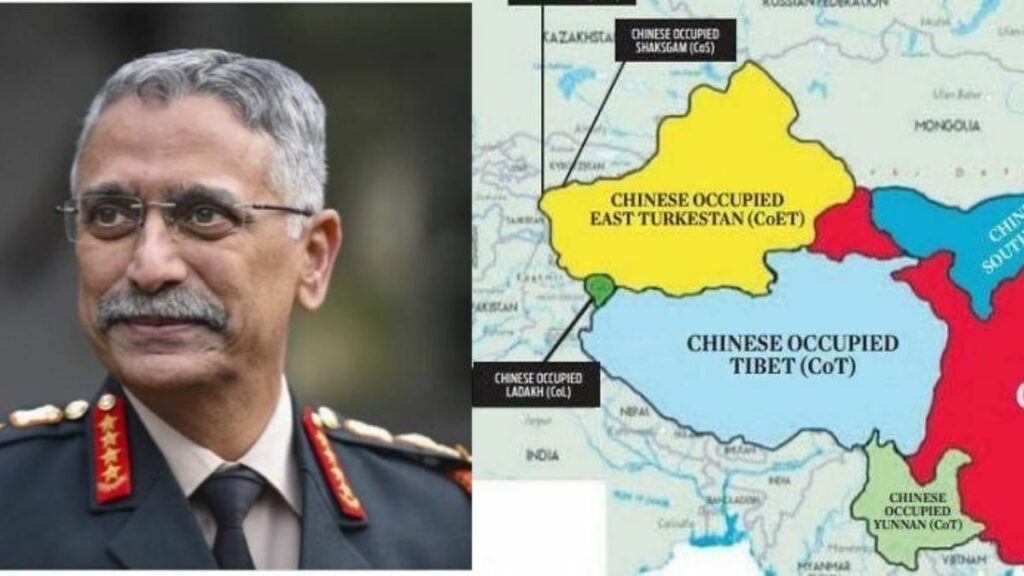Virendra Pandit
New Delhi: Former Indian Army chief General Manoj Naravane, on Tuesday, nailed China’s cartographical lies. Posting a map on X (formerly Twitter), he cryptically remarked: “Finally, someone got the map of China as it really is!”
Sharing the map on the microblogging platform, his caption exposed China’s latest lies on its claims that India’s Arunachal Pradesh and Aksai Chin were part of the Dragon’s footprints.
Currently, China shares borders with 14 countries, with all of whom it has manufactured border disputes. The multicolored map demarcated several regions as ‘occupied’ areas, including Ladakh and Tibet.
The 2023 edition of the official “standard map of China”, released on August 28, immediately enraged not only India but also Russia, with which China had signed a “limitless friendship” deal prior to the Russian invasion of Ukraine in February 2022.
Besides, several countries including Taiwan, Vietnam, the Philippines, Japan, and others also strongly protested against the age-old Chinese annexation policy, preceded by similar map-publishing. As in the past, the controversial map included Taiwan, the South China Sea, Arunachal Pradesh, and Aksai Chin as ‘Chinese territories.’
India rejected the so-called “standard map” and lodged a strong protest with Beijing. New Delhi also asserted that such steps only complicate the resolution of the boundary question.
Member countries of the Association of the South East Asian Nations (ASEAN) have also been insisting on a binding Code of Conduct (COC) on the South China Sea in view of China’s consistent attempts to assert its expansive claims over the region.
In recent years, India has increased engagement with the Republic of Taiwan, which China claims as its ‘breakaway’ island it will reclaim under the “One China” policy, by force, if needed. Currently, New Delhi has no diplomatic relations with Taipei but has been doing business with it through unofficial channels.
On August 8, for example, General Naravane, along with former Navy Chief Karambir Singh and ex-Air Chief Marshal RKS Bhadauria, visited Taipei and participated in the Ketagalan Forum’s 2023 Indo-Pacific Security Dialogue event, in which Taiwan’s President Tsai Ing-wen delivered the opening address. The function was organized by the Taiwanese Foreign Ministry
Three weeks later, while releasing the “standard map”, Beijing said it “firmly opposed” such visits, without directly naming India.
“China firmly opposes all forms of official interaction between the Taiwan authorities and countries having diplomatic relations with China,” Wang Wenbin, the foreign ministry spokesperson, said during a regular briefing in Beijing.
“This is our consistent and clear position,” Wang said, according to the official transcript of the press conference published on the Chinese foreign ministry website.
“We hope the country concerned will abide by the One China principle, prudently and properly handle Taiwan-related issues, and refrain from having any form of military and security cooperation with Taiwan,” he added.
The former Indian security chiefs’ Taipei visit was significant considering China has been flexing its military muscles around Taiwan. This visit generated speculation about India’s stand on China’s possible aggression against Taiwan.
Ties between India and China came under severe strain following the Eastern Ladakh border row that began in May 2020.
Indian and Chinese troops are locked in an over three-year-long faceoff at certain friction points in Eastern Ladakh even as the two sides completed disengagement from some areas following extensive diplomatic and military talks.
India has been consistently maintaining that peace and tranquility along the Line of Actual Control (LAC) were key to the normalization of overall relations.
China’s latest cartographic move came days before New Delhi hosted the G-20 Summit on September 8 and 10. Chinese President Xi Jinping, like his Russian counterpart Vladimir Putin, skipped it mainly because they both were fighting their internal demons and did not want to be seen as vulnerable overseas.
Officially, on August 30, China defended its move to release the new “standard map.”
Asked about India’s diplomatic protest by a Chinese state-run outlet, Wang Wenbin, the foreign ministry spokesperson, told a media briefing in Beijing that “on August 23, the Ministry of National Resources of China released the 2023 edition of the standard map.”
“It is a routine practice in China’s exercise of sovereignty in accordance with the law. We hope relevant sides can stay objective and calm, and refrain from over-interpreting the issue,” Wang said.

